A characteristic of hydraulic disc brakes is that the lever and pedal play does not increase as the brake pads wear. The reason play does not change is due to the caliper pistons gradually being pushed out. However, if the exposed pistons become dirty, they will not move properly, causing the pads to drag and rust. If you begin to hear a faint scraping sound, check the pistons for contamination and clean them properly.
- The caliper piston is exposed, and dirt will reduce the return.
- After cleaning, use appropriate lubricant to improve movement and prevent rust
The caliper piston is exposed, and dirt will reduce the return.
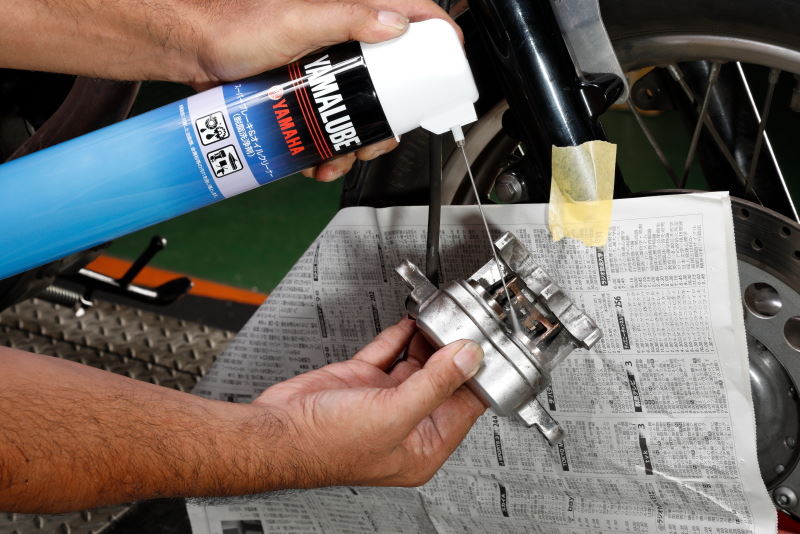

Calipers that are covered with pad dust, dust, or grit should be cleaned with brake cleaner or mild detergent. You can also put the entire caliper in a bucket of water and scrub it with a brush. After cleaning with water, completely blow off any remaining water around the caliper pistons with an air blow gun or similar device.
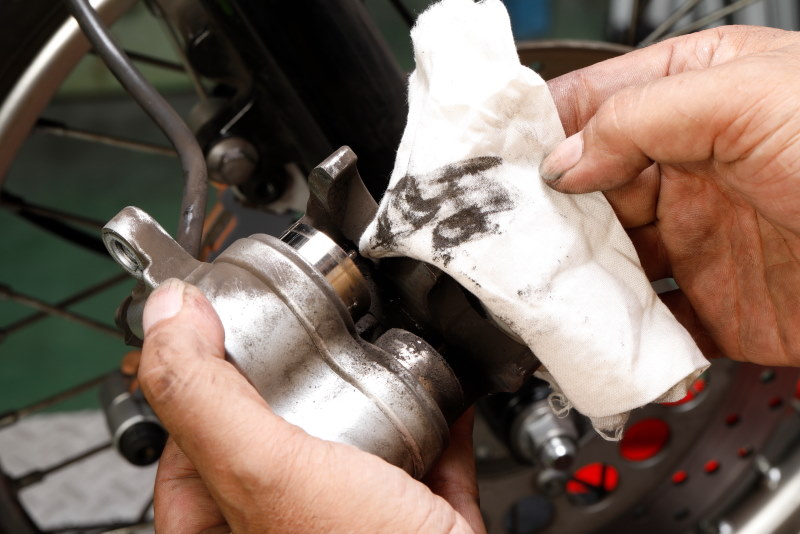

It is difficult for parts cleaners to penetrate dry pad dust, so it is sometimes quicker to scrub it off with a rag. It is important to clean not only the front side of the caliper, which is easily visible and accessible, but also the back side, which is hidden by the caliper itself. If you have a caliper piston pliers, you can work efficiently while turning the pistons.
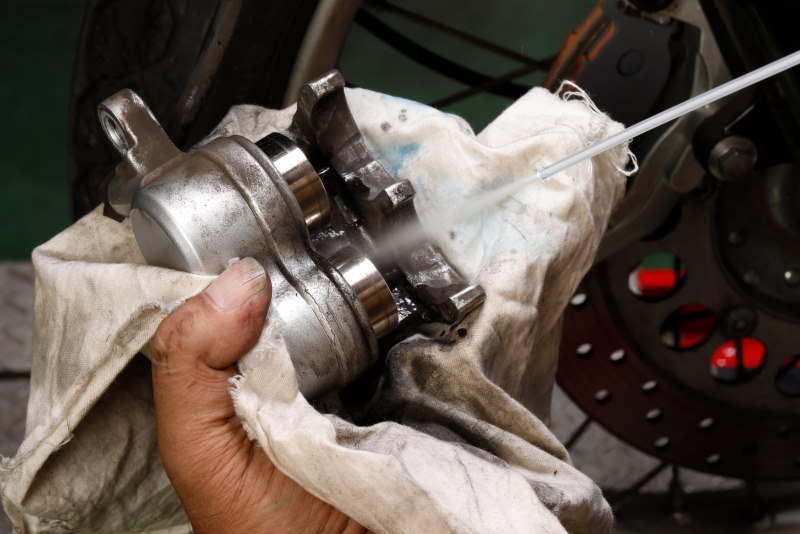

After wiping off the dirt with a rag, wash it off with parts cleaner. The calipers themselves can be cleaned in a bucket with a toothbrush and mild detergent, but spray-type parts cleaners have the advantage of being able to blow off the dirt with gas pressure, so they should be used in the right place at the right time.
The clearance between the brake rotor and brake pad should always be the minimum necessary for weight. If the caliper piston moves back significantly when the lever or pedal is released and the rotor and pads are far apart, the next time the brakes are applied, the lever or pedal stroke will be deeper and there will be a time lag. If the brake rotor bends even slightly due to a fall or contact, the pads are pushed apart by lateral runout during rotation, which can cause the lever to go deeper each time the brakes are applied, as if air is being chewed.
The piston seal and dust seal, which are incorporated into the caliper and in contact with the piston, play an important role in determining the clearance between the two. As the brake fluid pushes the piston out, the seal is pulled by the piston and slightly deformed. When the lever or pedal is released to release the fluid pressure from the caliper, the piston returns to the caliper side due to the force of the deformed seal returning to its original position, creating a small gap between the pad and the rotor.
Mechanical drum brakes, which are operated by wires and rods, require manual adjustment because the amount of play increases as the lining wears. However, with hydraulic disc brakes, as the pads wear, the caliper piston protrusion increases, and the amount of play remains constant, so the lever and pedal feel remains the same.
Looking at the relationship between the caliper piston and the seal, the piston repeatedly moves in and out of the caliper in the same position as long as there is enough pad remaining. However, as the pad wears down, the piston must be pushed out of the caliper because the gap between the caliper and the brake rotor increases. As a result, the more the pads wear, the more the pistons push out of the caliper.
While the piston is seated in the caliper, the outer circumference of the piston is lubricated with brake fluid. Fluid also adheres to the contact area between the seal and the piston, helping to ensure smooth operation.
However, when the piston protrudes, the caliper exposes the piston, which is covered with brake fluid. Since the seal acts as a wiper, there is no dripping, and some of the fluid will be washed away if moisture adheres to the caliper during rainy weather. However, a small amount of fluid or moisture can cause contamination of the pistons. Some of the powdery residue from worn brake pads can stick to the pistons, and gravel and dust from driving can also stick to the pistons.
Dirt on the caliper pistons increases the friction loss of the pistons themselves, and pistons that do not return to the calipers can cause the pads and rotors to drag. If you hear the pads and rotors rubbing against each other when you take your hand off the brake lever, check the pads and caliper pistons. Then, when dirt has accumulated on the pistons, clean them carefully with a mild detergent or brake cleaner.
- Point 1・Brake caliper pistons maintain proper gap between pads and rotors with the elasticity and resilience of caliper seals.
- Point 2: Dirt buildup on caliper pistons prevents smooth movement and contributes to pad drag.
After cleaning, use appropriate lubricant to improve movement and prevent rust
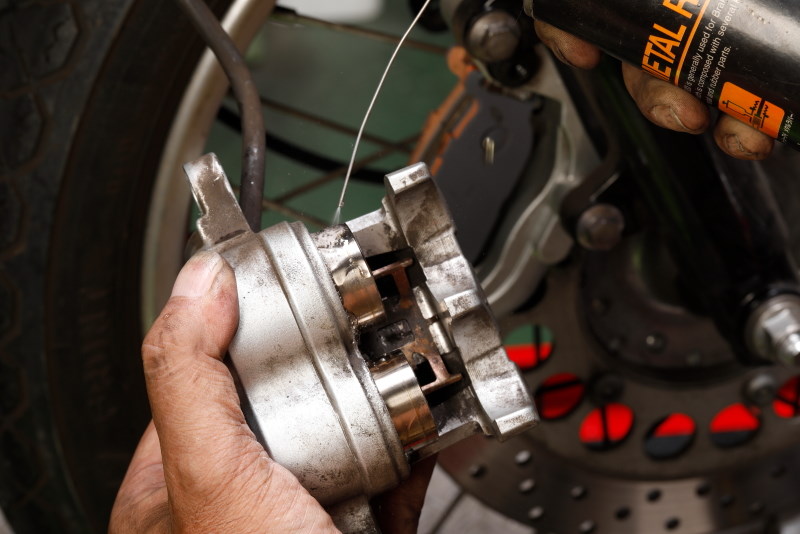

It is no exaggeration to say that metal rubber is a standard chemical when maintaining brake calipers and master cylinders. Some lubricants contain ingredients that can cause rubber to swell, so careful selection is necessary when using them on brake parts. Metal rubber has no effect on rubber and dissolves in glycol-based brake fluid, so it is safe to use inside calipers in contact with fluid. Conversely, it cannot be used on brakes that use silicone-based fluid, so be careful.
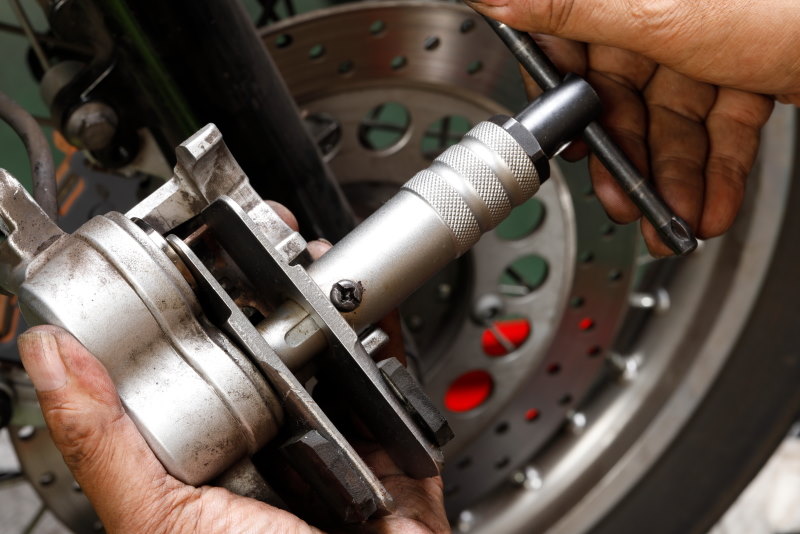

After applying the metal rubber, push the piston back into the caliper to spread the lubricant to the seal surfaces as well. By rubbing the caliper piston out and back in, it will move so smoothly that it can be pushed back in with a finger without a caliper tool.
Because of the heat transferred by the brake pads during braking, the caliper pistons remain relatively dry of dirt. However, brake fluid itself is a liquid that tends to attract moisture, so depending on maintenance conditions and storage conditions, rust may form on the pistons.
Rusting is most likely to occur at the boundary where the caliper seals come into contact and where a lot of dirt has accumulated. The pistons are treated with hard chrome plating, but the surface of the plating is invisible to the eye.?Because of the numerous holes in the unit, if moisture unfortunately permeates through them, rust will develop under the plating.
Cleaning is important to prevent this from happening, but degreasing and cleaning with a mild detergent or parts cleaner will remove the rust-preventive effect and leave the parts unprotected, so a chemical is applied to protect the surface and improve operability.
The lubricant used here is effective in lubricating the contact surfaces between metal and rubber. A typical product known as C.C.I. Metal Rubber, known by the part number MR20, is a chemical that provides excellent lubrication as an assembly fluid for brakes and hydraulic clutches. It is also characterized by its rust-preventing effect on metals and its ability to dissolve in glycol-based brake fluid without damaging rubber or resins.
When using the metal rubber, spray it evenly around the periphery of the caliper with the piston moving forward enough to prevent it from falling out of the caliper, wipe off any dripping excess, and push it back into the caliper. By pushing it back in with the metal rubber adhering to it, the dust seal and piston seal surfaces will be covered and the piston will operate better.
Cleaning and lubricating caliper pistons is effective not only when new brake pads are installed, but also when pads are in use. However, when worn pads are installed, the pistons tend to protrude more and become dirty, so it is advisable to wipe them with a rag to prevent too much metal rubber from remaining on the exposed areas.
- Point – Use of anti-rust lubrication chemical suitable for rubber seals after cleaning improves caliper piston operation.